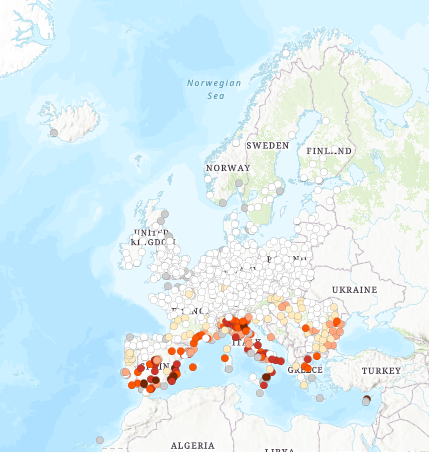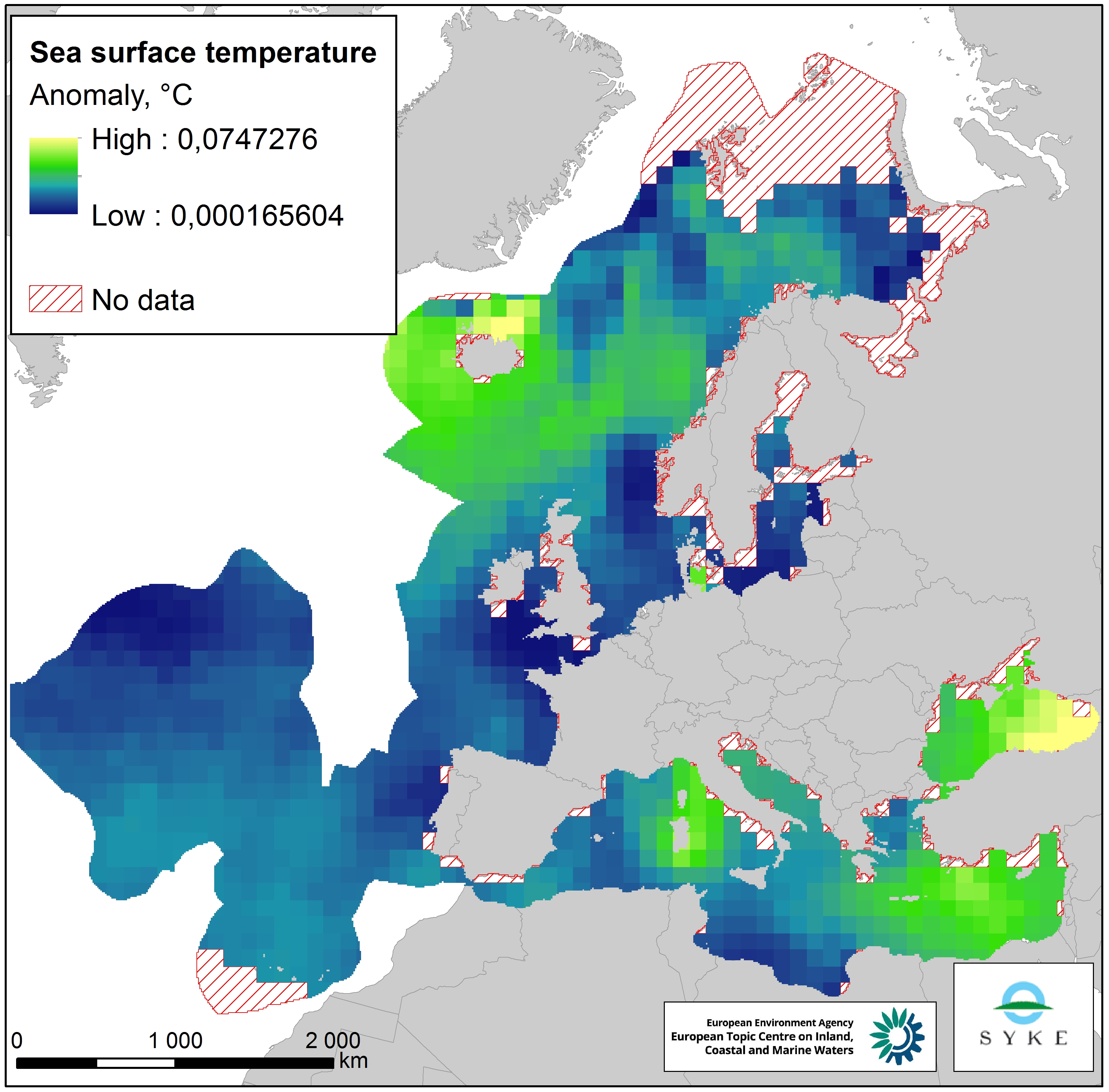temperature
Type of resources
Available actions
Topics
INSPIRE themes
Keywords
Contact for the resource
Provided by
Years
Formats
Representation types
Update frequencies
Scale
Resolution
-

The dataset presents average values of the number of days per year where the maximum temperature has exceeded 35 degrees Celsius from the period 1987- 2016, for a series of individual European cities from Eurostat's Urban Audit 2011-2014 spatial dataset. The associated values are based on the E-OBS dataset from the EU-FP6 project ENSEMBLES (http://ensembles-eu.metoffice.com) and around 10,000 meteorological stations across Europe. This dataset has been used also in the EEA Report No 22/2018 "Unequal exposure and unequal impacts: social vulnerability to air pollution, noise and extreme temperatures in Europe" (https://www.eea.europa.eu/publications/unequal-exposure-and-unequal-impacts/at_download/file).
-

The dataset presents the average number of combined hot days - with maximum temperature over 30 degrees Celsius - and tropical nights - with minimum temperature over 20 degrees Celsius - in the period 1987-2016, for a series of individual European cities from Eurostat's Urban Audit 2011-2014 spatial dataset. The associated values are based on the E-OBS dataset from the EU-FP6 project ENSEMBLES (http://ensembles-eu.metoffice.com) and around 10,000 meteorological stations across Europe. The combination of hot days and warm nights is particularly dangerous to human health, as the high temperatures during night time does not allow for the cities and buildings to cool down. Such combination, if lasting over several days (heatwaves) can have severe health implications or even be fatal to the elderly, babies or those in poor health. Therefore, the knowledge of the occurrence of such conditions in a given location can be useful in planning adaptation to the changing climate and protection of the vulnerable groups from heat. This dataset has been used also in the EEA Report No 22/2018 "Unequal exposure and unequal impacts: social vulnerability to air pollution, noise and extreme temperatures in Europe" (https://www.eea.europa.eu/publications/unequal-exposure-and-unequal-impacts/at_download/file).
-

This raster dataset represents the Sea Surface Temperature (SST) anomalies, i.e. changes of sea temperatures, in the European Seas. The dataset is based on the map "Mean annual sea surface temperature trend in European seas" by Istituto Nazionale di Geofisica e Vulcanologia (INGV), which depicts the linear trend in sea surface temperature (in °C/yr) for the European seas over the past 25 years (1989-2013). Since all changes of sea temperatures can be considered to have an impact on the marine environment, the pressure layer includes absolute values of SST anomalies, i.e. negative/decreasing temperature trends were changed to positive values so that they represent a pressure. The original data was in a 1° grid format but was converted to a 100 km resolution, adapted to the EEA 10 km grid and clipped with the area of interest. This dataset has been prepared for the calculation of the combined effect index, produced for the ETC/ICM Report 4/2019 "Multiple pressures and their combined effects in Europe's seas" available on: https://www.eionet.europa.eu/etcs/etc-icm/etc-icm-report-4-2019-multiple-pressures-and-their-combined-effects-in-europes-seas-1.
-

The raster dataset presents the median of the projected number of extreme heatwaves in the near future (2020–2052) in Europe, following the Representative Concentration Pathways (RCP) 8.5 scenario. The dataset is one of the multimodel ensemble used to project future occurrence and severity of heat waves under different RCP, which were adopted by the Intergovernmental Panel on Climate Change for its Fifth Assessment Report (AR5). The dataset is one of the output of the JRC “Number of heat waves” data described here: https://agupubs.onlinelibrary.wiley.com/doi/epdf/10.1002/2014JD022098. The dataset has been used as a source for the EEA indicator “Global and European temperature”: https://www.eea.europa.eu/data-and-maps/indicators/global-and-european-temperature-8/assessment, which in the meantime has been already updated.
-

The dataset presents the annual number of Cooling Degree Days (CDD) in average for the period 1990-2015, for a series of individual European cities from Eurostat's Urban Audit 2011-2014 spatial dataset, based on the E-OBS dataset from the EU-FP6 project ENSEMBLES (http://ensembles-eu.metoffice.com) and around 10,000 meteorological stations across Europe. This dataset has been used in the EEA Report No 22/2018 "Unequal exposure and unequal impacts: social vulnerability to air pollution, noise and extreme temperatures in Europe" (https://www.eea.europa.eu/publications/unequal-exposure-and-unequal-impacts/at_download/file), where CDD is defined as the sum of the difference in degrees between 21 °C and the mean temperature over the year, for the days when the mean daily temperature is higher than 21 °C. The number of CDDs is useful in differentiating between areas based on the need for cooling homes or workplaces. As a measurement designed to quantify the demand for energy needed to cool a building in order to keep it at a comfortable temperature, it is relevant to issues of thermal comfort and energy affordability.
-

The gridded dataset presents the median of the projected number of extreme heatwaves in the future (2068–2100) in Europe, following the Representative Concentration Pathways (RCP) 8.5 scenario. The dataset is one of the multimodel ensemble used to project future occurrence and severity of heat waves under different RCP, which were adopted by the Intergovernmental Panel on Climate Change for its Fifth Assessment Report (AR5). The dataset is one of the output of the JRC “Number of heat waves” data described here: https://agupubs.onlinelibrary.wiley.com/doi/epdf/10.1002/2014JD022098 The dataset has been used as a source for the EEA indicator “Global and European temperature”: https://www.eea.europa.eu/data-and-maps/indicators/global-and-european-temperature-8/assessment, which in the meantime has been updated.
 RUC Geo-Data catalogue
RUC Geo-Data catalogue